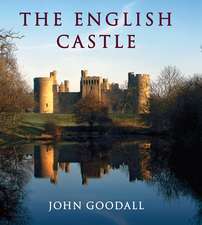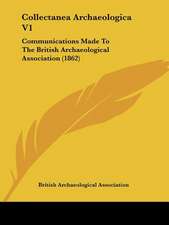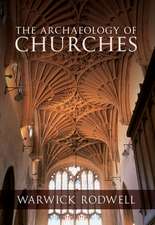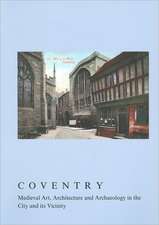Westminster Part I: The Art, Architecture and Archaeology of the Royal Abbey: The British Archaeological Association Conference Transactions
Editat de Warwick Rodwell, Tim Tatton-Brownen Limba Engleză Paperback – 31 aug 2016
Westminster came into existence in the later Anglo-Saxon period, and by the mid-11th century, when Edward the Confessor’s great new abbey was built, it was a major royal centre two miles south-west of the City of London. Within a century or so, it had become the principal seat of government in England, and this series of twenty-eight papers covers new research on the topography, buildings, art-history, architecture and archaeology of Westminster’s two great establishments — Abbey and Palace.
Part I begins with studies of the topography of the area, an account of its Roman-period finds and an historiographical overview of the archaeology of the Abbey. Edward the Confessor’s enigmatic church plan is discussed and the evidence for later Romanesque structures is assembled for the first time. Five papers examine aspects of Henry III’s vast new Abbey church and its decoration. A further four cover aspects of the later medieval period, coronation, and Sir George Gilbert Scott’s impact as the Abbey’s greatest Surveyor of the Fabric. A pair of papers examines the development of the northern precinct of the Abbey, around St Margaret’s Church, and the remarkable buildings of Westminster School, created within the remains of the monastery in the 17th and 18th centuries.
Part II part deals with the Palace of Westminster and its wider topography between the late 11th century and the devastating fire of 1834 that largely destroyed the medieval palace. William Rufus’s enormous hall and its famous roofs are completely reassessed, and comparisons discussed between this structure and the great hall at Caen. Other essays reconsider Henry III’s palace, St Stephen’s chapel, the king’s great chamber (the ‘Painted Chamber’) and the enigmatic Jewel Tower. The final papers examine the meeting places of Parliament and the living accommodation of the MPs who attended it, the topography of the Palace between the Reformation and the fire of 1834, and the building of the New Palace which is better known today as the Houses of Parliament.
| Toate formatele și edițiile | Preț | Express |
|---|---|---|
| Paperback (1) | 270.25 lei 6-8 săpt. | |
| Taylor & Francis – 31 aug 2016 | 270.25 lei 6-8 săpt. | |
| Hardback (1) | 902.48 lei 6-8 săpt. | |
| Taylor & Francis – 31 aug 2016 | 902.48 lei 6-8 săpt. |
Din seria The British Archaeological Association Conference Transactions
-
 Preț: 282.31 lei
Preț: 282.31 lei - 9%
 Preț: 941.15 lei
Preț: 941.15 lei -
 Preț: 302.63 lei
Preț: 302.63 lei -
 Preț: 314.64 lei
Preț: 314.64 lei - 22%
 Preț: 326.69 lei
Preț: 326.69 lei - 11%
 Preț: 391.41 lei
Preț: 391.41 lei - 25%
 Preț: 852.22 lei
Preț: 852.22 lei - 30%
 Preț: 770.74 lei
Preț: 770.74 lei - 11%
 Preț: 346.04 lei
Preț: 346.04 lei - 16%
 Preț: 244.53 lei
Preț: 244.53 lei - 12%
 Preț: 299.52 lei
Preț: 299.52 lei - 15%
 Preț: 303.64 lei
Preț: 303.64 lei - 17%
 Preț: 245.92 lei
Preț: 245.92 lei - 17%
 Preț: 254.30 lei
Preț: 254.30 lei - 12%
 Preț: 342.58 lei
Preț: 342.58 lei - 30%
 Preț: 782.13 lei
Preț: 782.13 lei - 25%
 Preț: 768.69 lei
Preț: 768.69 lei - 16%
 Preț: 252.40 lei
Preț: 252.40 lei -
 Preț: 289.37 lei
Preț: 289.37 lei - 12%
 Preț: 339.76 lei
Preț: 339.76 lei - 11%
 Preț: 346.01 lei
Preț: 346.01 lei - 14%
 Preț: 262.96 lei
Preț: 262.96 lei - 18%
 Preț: 249.24 lei
Preț: 249.24 lei - 25%
 Preț: 500.22 lei
Preț: 500.22 lei - 25%
 Preț: 487.01 lei
Preț: 487.01 lei - 17%
 Preț: 238.85 lei
Preț: 238.85 lei - 13%
 Preț: 298.10 lei
Preț: 298.10 lei - 25%
 Preț: 738.30 lei
Preț: 738.30 lei - 22%
 Preț: 485.50 lei
Preț: 485.50 lei - 9%
 Preț: 322.47 lei
Preț: 322.47 lei - 25%
 Preț: 740.82 lei
Preț: 740.82 lei - 25%
 Preț: 782.13 lei
Preț: 782.13 lei - 26%
 Preț: 765.84 lei
Preț: 765.84 lei
Preț: 270.25 lei
Preț vechi: 316.76 lei
-15% Nou
Puncte Express: 405
Preț estimativ în valută:
51.71€ • 54.14$ • 42.79£
51.71€ • 54.14$ • 42.79£
Carte tipărită la comandă
Livrare economică 05-19 aprilie
Preluare comenzi: 021 569.72.76
Specificații
ISBN-13: 9781910887240
ISBN-10: 1910887242
Pagini: 426
Dimensiuni: 174 x 246 x 23 mm
Greutate: 0.96 kg
Ediția:1
Editura: Taylor & Francis
Colecția Routledge
Seria The British Archaeological Association Conference Transactions
Locul publicării:Oxford, United Kingdom
ISBN-10: 1910887242
Pagini: 426
Dimensiuni: 174 x 246 x 23 mm
Greutate: 0.96 kg
Ediția:1
Editura: Taylor & Francis
Colecția Routledge
Seria The British Archaeological Association Conference Transactions
Locul publicării:Oxford, United Kingdom
Cuprins
CONTENTS [PART I THE ABBEY]
INTRODUCTION
TIM TATTON-BROWN The Medieval and Early Tudor Topography of Westminster
MARTIN HENIG ‘A Fine and Private Place’: The Sarcophagus of Valerius Amandinus and the Origins of Roman Westminster
WARWICK RODWELL The Archaeology of Westminster Abbey: An Historiographical Overview
FRANCIS WOODMAN Edward the Confessor’s Church at Westminster: An Alternative View
STUART HARRISON AND JOHN MCNEILL The Romanesque Monastic Buildings at Westminster Abbey
RICHARD JONES Numerical Archaeology: Gleanings from the 1253 Building Accounts of Westminster Abbey Revisited
PAMELA TUDOR-CRAIG The Iconography of Henry III’s Abbey: A Note Towards Elucidation of Themes
WARWICK RODWELL The Cosmati Pavements and their Topographical Setting: Addressing the Archaeological Issues
PAUL BINSKI AND EMILY GUERRY Seats, Relics and the Rationale of Images in Westminster Abbey, Henry III to Edward II
HELEN HOWARD AND MARIE LOUISE SAUERBERG The Polychromy at Westminster Abbey, 1250–1350
JANE SPOONER The Virgin Mary and White Harts Great and Small: The 14th-Century Wall-Paintings in the Chapel of Our Lady of the Pew and the Muniment Room
RICHARD MORTIMER History and Chronicles at Westminster Abbey, 1250–1450
NICOLA COLDSTREAM The Abbey and Palace as Theatres for Coronation
TIM TATTON-BROWN The New Work: Aspects of the Later Medieval Fabric of Westminster Abbey
STEVEN BRINDLE Sir George Gilbert Scott as Surveyor of Westminster Abbey, 1849–78
RICHARD FOSTER An Historical Sketch of the North Precinct of Westminster Abbey with Special Reference to its Prisons
EDDIE SMITH Westminster School Buildings, 1630–1730
INTRODUCTION
TIM TATTON-BROWN The Medieval and Early Tudor Topography of Westminster
MARTIN HENIG ‘A Fine and Private Place’: The Sarcophagus of Valerius Amandinus and the Origins of Roman Westminster
WARWICK RODWELL The Archaeology of Westminster Abbey: An Historiographical Overview
FRANCIS WOODMAN Edward the Confessor’s Church at Westminster: An Alternative View
STUART HARRISON AND JOHN MCNEILL The Romanesque Monastic Buildings at Westminster Abbey
RICHARD JONES Numerical Archaeology: Gleanings from the 1253 Building Accounts of Westminster Abbey Revisited
PAMELA TUDOR-CRAIG The Iconography of Henry III’s Abbey: A Note Towards Elucidation of Themes
WARWICK RODWELL The Cosmati Pavements and their Topographical Setting: Addressing the Archaeological Issues
PAUL BINSKI AND EMILY GUERRY Seats, Relics and the Rationale of Images in Westminster Abbey, Henry III to Edward II
HELEN HOWARD AND MARIE LOUISE SAUERBERG The Polychromy at Westminster Abbey, 1250–1350
JANE SPOONER The Virgin Mary and White Harts Great and Small: The 14th-Century Wall-Paintings in the Chapel of Our Lady of the Pew and the Muniment Room
RICHARD MORTIMER History and Chronicles at Westminster Abbey, 1250–1450
NICOLA COLDSTREAM The Abbey and Palace as Theatres for Coronation
TIM TATTON-BROWN The New Work: Aspects of the Later Medieval Fabric of Westminster Abbey
STEVEN BRINDLE Sir George Gilbert Scott as Surveyor of Westminster Abbey, 1849–78
RICHARD FOSTER An Historical Sketch of the North Precinct of Westminster Abbey with Special Reference to its Prisons
EDDIE SMITH Westminster School Buildings, 1630–1730
Notă biografică
Warwick Rodwell, Tim Tatton-Brown
Descriere
The British Archaeological Association’s 2013 conference was devoted to the study of Westminster Abbey and the Palace of Westminster. It also embraced Westminster School, which was founded at the Reformation in the Abbey precinct. Collectively, these institutions occupy a remarkable assemblage of medieval and later buildings, most of which are well documented. Although the Association had held a conference at Westminster in 1902, this was the first time that the internationally important complex of historic buildings was examined holistically, and the papers published here cover a wide range of subject matter.
















